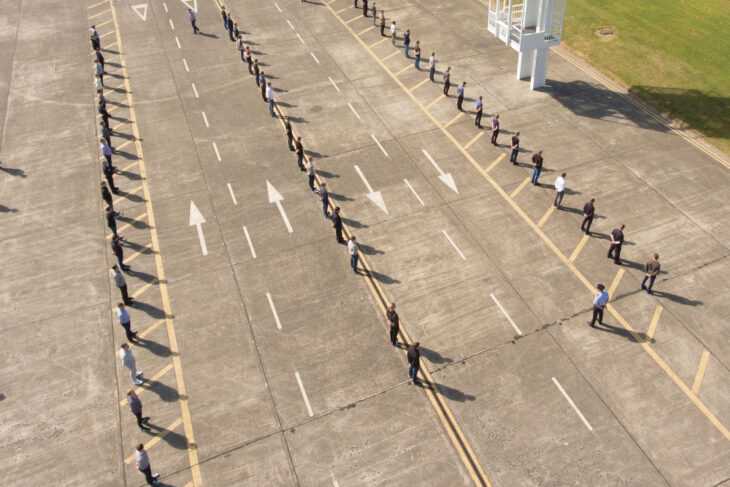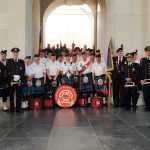Class 1/2020 have just completed their training under the most unusual circumstances. Course Director Tom Doolan tells Adam Hyland how hard work and discipline kept everybody safe.
In previous issues I have followed recruit training at the DFB Training Centre, but in the current pandemic, how the latest class has been prepared for service has seen dramatic but necessary changes and a monumental effort on the part of everybody at the OBI. I met with Course Director A/D/O Tom Doolan in July as the class neared the end of their training, and after going through sanitising and temperature checks, was shown around the grounds to witness just how this class of 54 were trained in complete safety under strict isolation guidelines. The spreading out of lockers, changing rooms and classrooms, and the separation of the group into syndicates of six who worked and ate together without ever mixing with other syndicates immediately brought home the amount of work done to ensure recruit and instructor safety, and the challenges the Training Centre faced in preparing this class for a career in the DFB. In itself, a class of 54 (48 from Dublin and several retained firefighters from surrounding counties, ranging from 21 to 46, plus nine instructors) is large and presents its own challenges. “It is a very broad group,” Course Director Doolan tells me.
“We have eight females included, and because of the COVID-19 plans in place, we actually have an all-female syndicate of six for the first time, as far as I am aware. Due to the requirement to isolate each syndicate in their own locker room we had to create an all-female syndicate.” With COVID-19 at its peak in April, the fact that training even went ahead is amazing, and testament to the work of the OBI staff, who were themselves unsure whether the course could go ahead.
UNCERTAINTY
“The class started on 27 April, two weeks before we planned to, to give us two weeks of breathing space if we had any issues or if we needed to pull back or catch up on any training that may have been missed due to the disease,” Course Director Doolan says.
“We were right in the middle of COVID-19 and cases were going up, so the reality was that we were going week by week. We didn’t know how far we would get, but we had planned to get through the whole training programme. “There was uncertainty amongst the recruits and among senior management, because there are obvious risks to running training courses during a pandemic. So, the recruits got a bit of a surprise when training did go ahead, and especially when they heard it was brought forward by two weeks.” Given the seriousness of the situation, the class was immediately faced with the strict guidelines necessary to undergo training in safety, on what must have been an unusual first day. “From the minute they came in here they were cordoned off from each other into their groups or pods,” Course Director Doolan tells me.
“We planned out our syndicates of six in advance and allocated where they were going to be lockered, where they were going to sit in classrooms, and the morning they arrived they were lined up outside, two metres apart, and brought in one by one, brought through COVID checks, hands washed, temperature checked, signed in, and then brought straight to their designated classroom space. Once we had everyone on site, I went around and explained exactly what was going to happen. So, the welcome to the DFB was pre-empted by the message of ‘this is COVID-19 and this is what we are going to do’.”
The Training Centre was closed to everybody but the recruit class and instructors, which meant the group could be divided into isolated pods and spaced out properly, using many areas that wouldn’t normally be used for training and keeping each group separated from others. Keeping such isolation measures in place were crucial, Course Director Doolan explains: “The general rule was that anybody coming in from the outside was considered a risk of cross-contamination to the class and instructors. It’s not a nice way to look at it but that was the reality.” With such measures in place from the outset, even the traditional first day photo of the class had to be re-thought, and a drone was brought in to capture the image of the recruits standing two metres apart in the drill yard, rather than on the front steps of the building, although each syndicate did get their photo taken there, at a safe distance from each other.
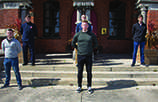

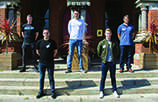
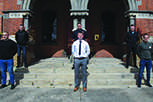
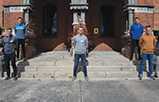

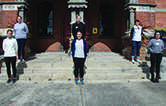
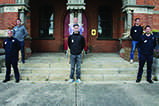
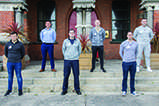
DISTANCING
To ensure this distancing remained in place meant a huge amount of preparation and constant monitoring. “My team planned well in advance,” Course Director Doolan tells me. “We came out to the OBI and put whatever plans were needed in place. The staff at the OBI had set up the place really well. They showed us what they had done to prepare and then handed it over and told us to do what we needed to do, to adapt it, improve it, whatever we needed. BTO Carroll, A/B/T/O Kiernan and all the staff had done a huge amount of great work to make it possible. “The mindset of everyone here now is different to what it was back in April. Even though COVID-19 hasn’t gone away, it is natural for people’s mindsets to change, but when we first came out here the situation was very bad. What we were coming up with was extremely cautious, but that’s what we needed to do because we had no choice.
We had to be as strict as possible with distancing.” As a walk around the grounds showed, this included strict signing in and temperature checks every morning at each pod, eliminating any chance of cross-contamination between syndicates during downtime, separate toilet and shower facilities, and an emphasis on reporting any signs or symptoms immediately. Gone too was the shared dining area, which meant extra work for the canteen staff, who had to prepare and hot-box all of the food for nine syndicates into takeaway carts and send it over to each pod. It also meant training courses had to be done differently, which required a lot of consideration. “The classrooms were a huge issue because we couldn’t fit everybody into the one class anymore due to the need to maintain social distancing,” Course Director Doolan tells me, “so they were broken into groups of three syndicates – 18 people in total – with the same classrooms, same desks each day, same people. Each desk was a minimum of 2.5 metres apart.
The problem we faced then was that we had three different rooms in which the same lecture had to be delivered. “We had to come up with a way to do it. There were IT options, but it isn’t the same as having an instructor in the room. I made the decision to group the lectures into groups of three, based on their natural place in the course structure and their length, giving three different lectures at the same time, so classroom 1 got lecture A, classroom 2 got lecture B, and so on. At the end of those lectures the instructors would then move to the next classroom, where they would deliver the same lecture, maintaining strict social distancing in the classroom at all times. “The advantage of this option was that the workload on instructors
was not trebled, because they were delivering the same lecture three times, rather than three separate lectures. Secondly, the consistency of delivery was assured.” When external lecturers were needed, such as for Health and Safety or HR, three lecturers were requested to provide the class to each group at the same time.


TRAINING
Practical training also presented challenges to overcome. “We were very conscious that recruits would not move between their syndicates when training on the drill yard, so when they were doing ladder drills, for instance, that syndicate and their instructor worked together as a unit and didn’t mix with any other.
Basic training was done this way, and when we went on to specialist courses, we used the same three-group approach, so one group of 18 would be doing RTC, one group of 18 would be doing BA, and so on. In previous recruit courses it would be normal to break up the syndicates after basic training and mix them up for the specialist courses so they could get to know each other, but obviously we couldn’t do that this time.
“New instructors would come in to do those courses, but we podded them as well, so within that course there was very little cross-contamination.” For other courses and in other situations, alternative measures or barriers to close contact were introduced. Social distancing couldn’t be maintained in the BA workroom where space was confined, for instance, so each recruit had to wear a surgical mask. Each recruit, however, was issued with a single BA mask for the entirety of the course, which had to be washed, disinfected and dried, then placed on their desk away from everybody’s else’s.
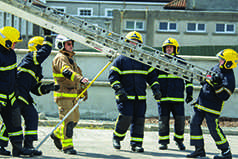
Despite the overriding issue of COVID-19, there wasn’t a specific course on dealing with it, but Course Director Doolan says that the overall emphasis on distancing and COVID guidelines meant each recruit clearly got a deep level of understanding of what was required. “The DFB Health and Safety Unit standard presentation on safety that is given to all new recruits had COVID-19 protocols added to it to reinforce everything we had already told them. We may as well have been doing standalone COVID courses because of the amount of time we spent talking about it. The class is constantly reminded of the safety protocols and their own role, and I have put a huge emphasis on each recruit taking personal responsibility both in the training centre and while off duty.
“It is absolutely drilled into them at this stage. The overall factor in this course has been COVID-19, but we can’t let that get in the way because we have to train each recruit to the same standard and they have to achieve the same competencies as anyone else. But each recruit has been fully drilled on how to operate within this environment.”
DIFFERENCES
Another challenge faced by the recruit class was the barrier towards group bonding, both within and outside the Training Centre, and the emphasis on working as a unit that can be so important in getting through the tough training process, but the group has managed to get by in other ways. “As a class overall there are people who won’t get to know each other well, especially those in other groups,” says Course Director Doolan, “but on the flipside, the syndicates have spent more time together than they ever would have previously, so they certainly got to know each other, and the groups of 18 have been together through the whole course. So, what they have lost out on in some ways, they gain in other ways when it comes to camaraderie.” Another difference for this class was that because of distancing and uncertainty, they didn’t begin marching training early in the course. “We didn’t know how far we were going to get with the course, so we were trying to get as much practical work done as possible,” Course Director Doolan says.
“When COVID-19 cases started to settle down, we thought we might just get to the end of training, there might be a pass out, so we would need to teach the class to march.” Within their final weeks, marching training was in full swing, with each recruit wearing a mask, but this too led to some very different situations. “When they started marching as a group, people who didn’t have much contact with other groups were all of a sudden thinking: ‘Who is that?’ because they were seeing people they swore they had never seen before,” Course Director Doolan laughs. Despite these challenges, the recruit class has got on very well, he adds.
“You will always have a broad mix of character types, and this class is no different, even if they know they will probably be called the COVID class forever. But they are achieving the same standard as any other course, absolutely, because we can’t afford to let anyone out of here who doesn’t achieve those standards. COVID makes no difference to that whatsoever.” One addition to the course was a new wildfire fighting module, which has yet to be delivered operationally. “We may as well train the class in everything we can while we have the 54 here,” Course Director Doolan explains. “When they are scattered to the four winds, to bring them all back in for another course or module is almost impossible, but if we can train them when they are a captive audience, then it makes sense to get it done.”
PASS OUT
At the time of writing, pass out is due on August 19, but there has been uncertainty about this too, due to changes in Government guidelines on social distancing and restrictions, as Course Director Doolan explains: “We don’t yet know what format it will be, but it is now on the table, and it is brilliant to have been able to do that. At the moment we are prepping for a proper pass out where the recruits will do their display. The initial plan was to film and livestream it, with no guests in attendance because the regulations at the time were for no more than 20 people, which is obviously quite minimal.
Then things moved on where you could have 100 people together, and now it is at 200. It was supposed to go to 500 but that has been rolled back, so 200 is quite tight for us, especially for a class of 54. This is reviewed again on August 10, which is nine days before pass out. If it is 500, we are in a good place, but if it is 200, we are going to have to restrict it to two people per recruit. “Irrespective of what the number is, this will be a ticketed event, so nobody without a ticket will be allowed in. We need to be able to control the numbers and know exactly how many people we have there, and who they are.
This includes everybody from the Chief Fire Officer to the Lord Mayor. We need to maintain a list of every single person who is here so we can do contact tracing. “Throughout this course I have had to make three or four plans for everything, because we don’t know where things are going. With pass out it is exactly the same. We are still going to livestream it, even if we are allowed to have 500 there, because we need to have back up plans in place. We have no choice. “I’m very mindful of how this affects people and I’m not happy that recruits might not be able to bring all of their family on the day, because they are the ones who have sacrificed a lot in terms of having them here training so hard for the last few months, but we can’t go against the guidelines.
The pass out day is all about the recruits and their families and it is a big regret of mine that there is a possibility we will not be able to bring all of their family.” Another bonus for us is that rather than having some recruits assigned to stations while others stay on to start the paramedic course, all of the class will start paramedic training after two weeks, apart from four previously qualified paramedics. Course Director Doolan sees this as a positive, as he says the whole class can complete their Paramedic training together and nobody will have to wait until the next recruit class.
By the time this comes out, we will know what form the pass out took, but congratulations are due to all of the recruits for passing the course in such strange and challenging circumstances. Congratulations and thanks are also due to all of the people who helped make this recruit training programme happen, and Course Director Doolan says he is very grateful to them all. “I’d like to thank all of the staff at the OBI,” he says. “Many thanks to B/T/O Brendan Carroll and A/B/T/O Frank Kiernan, as well as D/O Paul Lambert, all of the Admin office staff and those working from home but who were always available, the FF/Ps attached here permanently, and all of the catering staff. We also had huge assistance from DFB Logistics who pulled out all the stops to get equipment and uniforms to us ahead of the original planned dates. “I’d also like to express my appreciation to all of the specialist instructors who gave up their time to provide vital training to the recruits.
“Lastly, I’d like to express my appreciation to my Assistant Course Director Peter Sherlock and to all of my syndicate officers who did Trojan work to overcome massive complications that would not normally be a factor in a recruit course. Training recruits is normally a difficult and time-consuming task, but the effort put in by the instructors for this class has been unbelievable. “All of these people can’t be forgotten. They have all had their workloads massively increased in order to see this happen, and I’m extremely grateful to all of them.”

